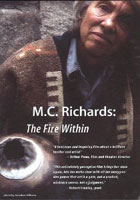| » Cover | ||
|
Essays
I cannot praise enough this inspiring and beautiful documentary about M. C. Richards. Richards, famous for her stint as a professor at Black Mountain College, and for her work at Camphill Village, an intentional agricultural community for adults with developmental disabilities inspired by Rudolf Steiner's Anthroposophical educational theories—made her greatest contribution within the framework of these theories. The Fire Within, through numerous interviews with Richards and her colleagues and friends, clips of her lecturing, working on her own art, interacting with the villagers at Camphill, and being "M. C.", articulates Richards' creative vision, and skillfully conveys her radiant personality. I met Richards once and I felt, in watching this film, her presence. Folksy, quirky, pixie-like, dancing around her kitchen, moaning ecstatically while painting, potting, cooking, or teaching, she turns sage and brilliant observer of the human creative spark when she speaks: "Are you going to be an earthy person, practical down-to-earth, get to it—or are you going to be a dreamer, a visionary (mumbles and moans)? You're going to be both. And we can't be, we shouldn't be talked out of it. I am both! Don't tell me I have to choose! Don't tell me I have to choose! I am both / and. I live in the Crossing Point." A light-spirit, but with an earthy, grounded wisdom that showed she lived, indeed, in her contradictions. Richards was not a competitive person, nor artist—she believed in the joy of what is given. She viewed life as a challenge to Being, and the creative act as the essential path to actualization. For her "imagination is spiritual perception, and authenticity is spiritual presence." To be authentic was to live not only in the present moment, but to live joyfully, and to laugh at life's toxic moments. She stated, "I am more interested in originality than I am in consensus and social approval." Watching her pat and kiss one of her paintings, Resurrected Gathering of Angels and Witches, and tell it, "I owe you a gift. I owe you a present. You did me a good deed. You did me a good deed," one seems amazed, charmed, and convinced by her sincerity and the revelatory spirit of the act. In the film, one critic and friend, theologian Marjorie Zoet Bankson, observes that Richards always walked at the edge of expression. You can feel that too watching Richards guide a group of students through a tactile experiment with a clay object—a giant elongated piece of unfired clay to which each student had contributed. Another interviewee, poet, artist, and friend Julia Connor described Richards' creed as spiritualizing the physical, always pointing at what had not yet been seen. At one point the director Richard Kane inquires how one "taps into" experience, into art, and Richards jumps back and quickly, but gently and embracingly, corrects him—the most important thing is receiving not tapping, the act of creativity is receptivity, not a taking away, but a gift. The Fire Within witnesses to an extraordinarily radiant life and philosophy. Her pottery and paintings, a joy in themselves to see, tangibly evidence Richards' incarnative capacities as artist and thinker. Richards spirit is infectious, her luminosity nourishing, and her sense of humor and depth of feeling magnetic. This is one of the most important films about the practical power of art and spirituality that I have ever seen.
|
|||||
